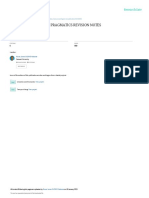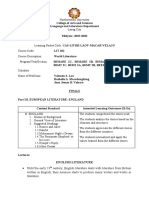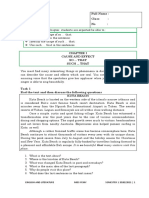Discourse Analysis Notes
Uploaded by
28. Km Icha Sri HandayaniDiscourse Analysis Notes
Uploaded by
28. Km Icha Sri HandayaniTERBARU (untuk nama2 journal nya nani aku ngisi di ppt)
discourse analysis
Basic ideas in discourse analysis
1. textual analysis (writing) : cohesion, coherence
2. conversational analysis (speaking) : utterance and communicative
acts
Definition of discourse analysis :
According to Brown and Yule (2008:13)
discourse analysis is an analysis of the language used which looks at the function of
language and what language is used for.
Basically, analysis is one of the objects carried out
to reveal the identity of the object. ( source :
http://digilib.uinkhas.ac.id/12441/1/11.%20Artikel%20Jurnal%20BIRCI%20AWK
%20Markesot%20Bertutur%20Lagi%20%28MBL%29.pdf )
simple def :
1. cohesion : Cohesion is the relations of meaning which exist within the text and justify
it as a text. Cohesion is lexical and grammatical unity within a text. Without cohesion,
a text will not make meaning.
simple def : cohesion refers to the grammatical and lexical thinking that holds a text
together and contributes to its meaning
There are two types of cohesion : lexical and grammatical
lexical cohesion : lexical cohesion refers to how the writer uses lexical elements
we can achieve cohesion lexically through : repetition, synonym, antonym, hyponym,
meronym
a. repetition : repeating the same words
i.g : cats are cute, i like cats
b. synonym : a word that means exactly the same as another word
i.g : John saw a snake under the table. the serpent was probably hiding there
for a long time.
c. antonym : two words with opposite meaning
i.g : old movies are boring, the new ones are much better.
d. hyponym : a word that denotes a subcategory of a more general class.
i.g : i like mango. The fruit is sweet and delicious.
e. meronym : a word that denotes part of something but which is used to refer to
the whole of it.
i.g : more workers are needed. we need more hands to finish the work.
Grammatical cohesion : refers to the grammatical relation between text elements.
we can achieve cohesion grammatically through : anaphora, ellipsis, substitute,
conjunction
a. anaphora : is when you use a word referring back to another word used
earlier in a text or conversation
i.g : Jimmy was brilliant. he got the best score
b. ellipsis : words or phrases are deleted from a sentence, but their meaning can
still be understood from the context.
i.g : full sentence : i want to go but i can’t go
ellipsis : i want to go but i can’t.
c. subtitutions : refer to the use of a word to replace another word
i.g : original sentence : : My sister bought a new lipcream. the lipcream is
expensive
substitutions : My sister bought a new lipcream. it is expensive.
d. conjunction : part os speech that connect words, phrases, clauses, or
sentences (and, or, but)
i.g : I read novel and magazine
TAMBAH ANALISIS COHESION AND COHERENCE (nanti aku tambahin,
tadi baca2 blm ada yg pas)
(kesimpulan)
coherence is what makes a text semantically meaningful. ia a coherent text,
ideas are logically connected to produce meaning.
cohesion refers to the grammatical and lexical linking that holds a text
together and contributes to its meaning.
a text may be cohesively connected, yet may still be incoherent.
there are two types of cohesion : lexical and grammatical.
2. conversational analysis (speaking) : utterance and communicative acts
Utterance and communicative acts are indispensable concepts in
spoken discourse. Utterances are used to perform communicative acts.
Communicative act is structured according to the three levels of
speech act: locutionary act, illocutionary act and perlocutionary act because it
is believed that utterance performs action at each level of speech act.
(PAKE YG DI PRAGMATICS)
ini di salin nanti di ppt ( aku gabisa nyalin disini nok)
Locutionary :
The importance :
You might also like
- 6th Grade - Housework Chores Worksheet PDFNo ratings yet6th Grade - Housework Chores Worksheet PDF5 pages
- Engli 420 Semantics Pragmatics Revision NotesNo ratings yetEngli 420 Semantics Pragmatics Revision Notes36 pages
- Introduction: Basic Concepts: Course: PsycholinguisticsNo ratings yetIntroduction: Basic Concepts: Course: Psycholinguistics17 pages
- Speech Act in The Great Gatsby Movie Script 2014-2015 By: Winda Ayu Citra Dewi IAIN TulungagungNo ratings yetSpeech Act in The Great Gatsby Movie Script 2014-2015 By: Winda Ayu Citra Dewi IAIN Tulungagung31 pages
- A. Semantics: It Is The Entire System of Meanings of A Language, Expressed by Grammar As Well As by Vocabulary100% (1)A. Semantics: It Is The Entire System of Meanings of A Language, Expressed by Grammar As Well As by Vocabulary4 pages
- Unit 1, Basic Ideas in Semantics - Handout100% (2)Unit 1, Basic Ideas in Semantics - Handout39 pages
- BS 4th Semantics Sense Relations and Lexical Relations by Qurratulayn KhanNo ratings yetBS 4th Semantics Sense Relations and Lexical Relations by Qurratulayn Khan10 pages
- Verner'S LAW: Made By: Selina Daria UT-20-1No ratings yetVerner'S LAW: Made By: Selina Daria UT-20-18 pages
- Introduction to East African Oral Literature NotesNo ratings yetIntroduction to East African Oral Literature Notes89 pages
- The Role of Context in Interpretation: Reference Presupposition Implicatures InferenceNo ratings yetThe Role of Context in Interpretation: Reference Presupposition Implicatures Inference24 pages
- Chapter 5: Word Formation: Presented By: Ms. Sadaf SiddiqNo ratings yetChapter 5: Word Formation: Presented By: Ms. Sadaf Siddiq16 pages
- Pragmatic Analysis of Interrogtive Speech Act Inas SaffatNo ratings yetPragmatic Analysis of Interrogtive Speech Act Inas Saffat16 pages
- Linguistics, Penguin: Module 2 Unit 2 Error Analysis 1No ratings yetLinguistics, Penguin: Module 2 Unit 2 Error Analysis 17 pages
- BGG. Môn Ngữ Pháp Lectures On English GrammarNo ratings yetBGG. Môn Ngữ Pháp Lectures On English Grammar168 pages
- Semantics: Titik Sudartinah English Language and Literature Study Program Yogyakarta State UniversityNo ratings yetSemantics: Titik Sudartinah English Language and Literature Study Program Yogyakarta State University163 pages
- Words Sentences and Dictionaries Group 2updated100% (1)Words Sentences and Dictionaries Group 2updated21 pages
- Semantic, Lexical and Syntactic Evolution of The English Language As Exemplified by The Merchant of Venice - Laura Santa Cruz Reviewed PDFNo ratings yetSemantic, Lexical and Syntactic Evolution of The English Language As Exemplified by The Merchant of Venice - Laura Santa Cruz Reviewed PDF25 pages
- Definition: Discussion:: 1 - CHAPTER 1: What Is Phonology?No ratings yetDefinition: Discussion:: 1 - CHAPTER 1: What Is Phonology?48 pages
- Analysis and Summary of Chapter 9 Things Fall Apart by Chinua AchebeNo ratings yetAnalysis and Summary of Chapter 9 Things Fall Apart by Chinua Achebe3 pages
- A Contrastive Analysis of English and Hausa Proverbs in Selected Texts100% (2)A Contrastive Analysis of English and Hausa Proverbs in Selected Texts144 pages
- Differences Between Oral and Written DiscourseNo ratings yetDifferences Between Oral and Written Discourse44 pages
- English Conversation Workshop - Beginner Level TEACHERNo ratings yetEnglish Conversation Workshop - Beginner Level TEACHER3 pages
- Nur Asisah, X MIA 2: Berikut Daftar Irregular Verb Dan Artinya Dalam Berbagai AbjadNo ratings yetNur Asisah, X MIA 2: Berikut Daftar Irregular Verb Dan Artinya Dalam Berbagai Abjad12 pages
- First Conditional: If + Present Verb, Future VerbNo ratings yetFirst Conditional: If + Present Verb, Future Verb1 page
- CELEX - INGLES - INTER2 - Segundo ExamenNo ratings yetCELEX - INGLES - INTER2 - Segundo Examen20 pages
- Clause Sentence: Sarah Smiled. Jo Doesn't Feel WellNo ratings yetClause Sentence: Sarah Smiled. Jo Doesn't Feel Well3 pages
- Instrumento de Evaluación - Check - List - 3No ratings yetInstrumento de Evaluación - Check - List - 32 pages
- Blue and Yellow Illustrative Benefits of Learning English PresentationNo ratings yetBlue and Yellow Illustrative Benefits of Learning English Presentation7 pages





























































































